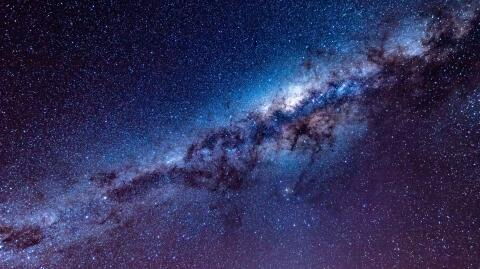She sits in the sky every evening, thin or plump, observable with a space telescope as well as with the naked eye. Her cycles, phases and eclipses have been well known to Humans for thousands of years. NASA has even sent its astronauts there, and now, fifty years later, plans to send them again—with female crewmembers for the very first time. The Moon and its characteristics have (almost) no secrets for scientists.
Discover our latest podcast
That is, except for one of the most intriguing secrets: its origin. The moon orbits the Earth and is currently among the largest satellites in the Solar System, even beyond all the moons of planets Jupiter, Saturn, Uranus, Neptune, Mars. But how did the Moon come to be?
It is estimated that the birth of the Moon dates back to around 4.51 billion years ago. As to its formation, several theories have also been put forward, without either of these hypotheses having been verified by astronomers... for now.
The 'giant impact' theory as the most likely
The most widespread idea remains that of the giant impact from a protoplanet—a planet still forming—roughly the size of Mars on our blue marble. This sucker-punching protoplanet was named Théia in reference to the eponymous goddess in Greek mythology, daughter of Ouranos (Heaven) and Gaia (Earth), mother of Selene (Moon). The shock-wave would have spread planetary debris in orbit around the Earth, destined to eventually agglomerate in a bombardment, forming the Earth's grey sentinel.
However, there is a catch: the chemical compositions of the Earth and those of the Moon, confirmed thanks to the samples of the Apollo expeditions in the 1970s, are not identical. In particular with regard to the proportion of iron that they both contain. However, it is possible that at the time, a large part of the earth's iron had already migrated downards into the core, so that the chunks of ejected mantle were loaded with very little surface iron.
Other more or less dismissed ideas about its origin
Despite the remaining questions, this theory is currently the most plausible. A second scenario, nicknamed the 'fission' scenario, suggests that the Earth would have ejected a fraction of itself when it was still only a rotating liquid mass. With the aid of the centrifugal force, these Earth-borne debris would have clustered together to lead to the formation of the Moon. But this event would have required a speed of rotation far too high.
Some research envisions a simultaneous creation of the binary objects Earth/Moon around the Sun, from the same source of celestial dust. This would not explain, however, why the first celestial object has a much larger core than the second. It would also not explain the geochemical differences between the two. That last point is what lead others to imagine that our natural satellite was born elsewhere in the Solar System, before it was flung inward by a Jovian encounter, and captured by the Earth's gravity field. But the Moon is far too massive to have been captured by the gravity field of a planet the size and mass of the Earth.
Finally, a theory developed in the 1980s and brought up to date in recent years is gradually gaining ground—what if the Moon was not born from a giant collision, but from a succession of multiple impacts of different celestial bodies (several small Théia, as it were)? Mini-moons would have formed, before merging together to form our considerably larger-than-usual moon. A plausible scenario, since during the dawn of the Solar System, collisions were certainly more frequent.
New data with the Artemis mission in 2024
Faced with these many theories, how to find out more? Thanks to the coming efforts to sample the Moon! Indeed, the samples taken fifty years ago were only taken from the lunar surface, where the composition may have been modified due to meteorite impacts (forming craters at the same time) or by cosmic radiation.
They were also extracted from the same place, in the centre of the visible side of the Moon. Who may know what fragments of space rocks from its 'dark side' and may reveal to us.















